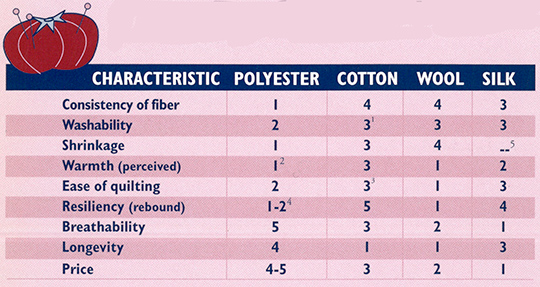How to Choose Batting: Part 1
Posted by Harriet Hargrave on Nov 4th 2015
Today, we're proud to bring you part one of Harriet Hargrave's (of Quilter's Academy fame!) comprehensive guide to what every quilter needs to know about batting!
Use the rating system below to evaluate the pros and cons of each batting fiber. The range is 1-5, with 1 representing the best performance or least expensive.

Cotton
• Cotton sticks to the fabric, making it easy to machine quilt, but it can be more difficult for some hand quilters to needle. Bleaching cotton makes the fiber drier, causing more drag on the thread when hand quilting. The natural, unbleached battings tend to be easier for hand quilters to use.
• Cotton shrinks, giving an older or antique look to quilts where the batting and fabrics have not been prewashed.
• Cotton is a very comfortable fiber. It breathes, allowing excess heat to escape and keeping you from getting too warm under cotton quilts. It is one of the best fibers for baby quilts.
• Cotton endures, becoming softer with age if quilted adequately.
Wool![]()
• Wool is very warm and lofty without being heavy. It has the ability to retain its loft and recover from compression better than any other fiber. This resiliency offers long-lasting beauty and warmth. Wool quilts and comforters can be aired twice a year to reinstate loft and fullness to the fiber.
• Wool breathes, keeping it from getting hot and keeping our skin warm yet dry. It moderates temperature,so that you never get overly hot or overly cold sleeping under it.
• Wool can also absorb up to 33% of its own weight in moisture without feeling damp, as opposed to 4% for synthetics. This makes it a perfect quilt to be used in a damp, cold climate.
• Wool is naturally flame-resistant. When it's exposed to fire it smolders at a low temperature and self-extinguishes with a cool ash, making it an extremely safe fiber to use for small children.
• Wool is extremely easy to hand quilt, often referred to as "quilting through butter."
Polyester
Polyester battings can give you the loft that is lacking in cottons, as well as more warmth. However, for some, it's a fairly hot product to sleep under, as it does not have the ability to breath and keeps the heat and moisture from dissipating. Polyester batts tend to be very stretchy and are not the best choice for a quilt that is going to hang on a wall for any period of time. Distortion is a problem when some areas are quilted heavily and others lightly. It is one of the most difficult battings to machine quilt,but hand quilters tend to get very small stitches in the new soft products. Polyester does not shrink, so an antique appearance is not possible, but if loft and a smooth look is what you want, it does a nice job.
Silk
Today's silk battings can be hand washed in cold water, drip dried, and air fluffed, using no heat at any time. It can be made thin or thick depending on how much you stretch and feather the fibers on to the project. It is recommended that stitching lines be within 1 12" minimum and that you avoid excess handling of the batting.
Testing Batting: Make Sample Squares to Compare Brands
Collect three to five 14" squares of every batting available to you. Cut three squares each of each batting (cannot be preshrunk) ,and five of batting that can be preshrunk. Label each brand. Next, make a pile of 14" squares of preshrunk muslin and unwashed muslin (quilt-shop quality only). Label the squares, and in the center of each draw a perfect 6" square with a permanent marker.
For the backing squares, sew a 7 1/4" strip of black cotton to an equal size muslin strip. Cut the strips into 14" squares. You are now ready to layer the batting and fabric together. Do so in the following manner:
1 piece of non-washed batting with non-washed fabric–top and back
1 piece of non-washed batting with pre-washed fabric– back
1 piece of pre-washed batting with non-washed fabric–top and back
1 piece of pre-washed batting with pre-washed fabric–top and back
Label each muslin square with the brand, and if the batt and fabric are preshrunk or not. Keep the extra square of non-washed batting to compare against new batts of the same brand (to check consistency).
Quilt the samples. If you hand and machine quilt, do both on the same sample. Once the squares are quilted, remeasure the 6" square. Check the loss of size from quilting (if any) with the formula: % shrinkage (or growth) = original length - new length (divided by) original length x 100. Note any contraction, or loss of size from quilting.
Wash and dry the quilt blocks as you would a finished quilt. Then, keep all samples from the same brand of batting together. Form your opinions.

Watch out for part two next week!







